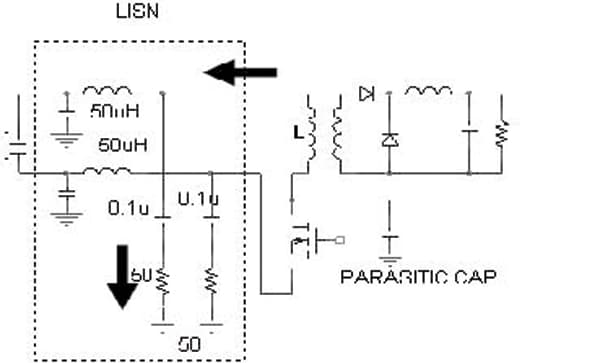Electronic switching circuits are used for power conversion, data communication and other applications. According to the theory of Fourier Transform, in these circuits, the periodical change of the current/voltage produces harmonics in a wide frequency spectrum. The resultant currents of these harmonics are called conducted emission (CE), and are categorized classically as differential and common mode (DM, CM) currents — or noises. While the existence of differential current is trivial, the concept of CM current, which implies that the currents in two different circuits are equal for the whole frequency spectrum, raises some questions about its credibility. CM current, as a reminder, is the current that circulates through the parasitic (capacitance) to the Chassis (Ground).
CM currents are the main contributor to radiated emissions. In power supply applications, where the power and return wires are usually unshielded, the big loop consisting of the power (return) wire and its “ground return path” is the main reason for radiated emissions. In systems that use differential signaling to establish communication, the signal wires are usually shielded. In these systems, the ground path, which usually is made on the surface of the shield, produces emission, which acts like an antenna element.
In this paper we focus on the mechanism of the generation of common mode noise in switch mode power supplies. This investigation will show the limitation of the applicability of the CM concept. We will also show that we need to introduce a new concept if we want to provide a correct explanation for the ground return current.
GENERATION OF COMMON MODE CURRENT IN A TYPICAL SWITCH MODE POWER SUPPLY
Figure 1 shows the schematic of a power supply with Line Stabilization Networks (LISN) in Power and Return lines. LISNs are used for controlling power supply impedances. In this circuit the inductance as seen by the primary of the transformer and the leakage capacitance existing at the drain of the MOSFET are the main components contributing to the generation of common mode noise. Upon switching of the MOSFET, the variations of the magnetic and electric fields produce current that pass through parasitic capacitance to the chassis. The ground (chassis) return current of the power line is shown in Figure 1.
In Figure 2, a differential capacitor C has been installed between power and return wires to reduce the differential current. With the insertion of this capacitor, part of the ground return current of power line now is diverted, by capacitor C, to return line. Actually the common mode current is generated. In order to have equal currents on Power and Return lines, the impedance of the capacitor should be zero in all frequency range. We know that capacitors are far from having this property. In conclusion, we can say that CM currents exist, partially, in some frequency range. We see that the ground return currents are different in Power and Return wire.


SINGLE MODE CURRENT
From the above discussion, we can conclude that, ground return currents can be divided to common mode and single mode (SM) currents. Single mode current is that part of the ground return which passes only through one wire.
With the introduction of Single Mode ground return current, we can understand that the limitation of CM mode choke in reduction of ground return currents (SM + CM). CM chokes also suffer from phase introduced by the differential capacitor (C) and low impedance at low frequency.

APPLICATION OF SINGLE MODE
EMI filters are used in Switch Mode Power Supply to reduce the noise generated by switching devices. Ferrite chokes and capacitors that are used in these filters, suffer from low frequency inefficiency and high frequency resonance which leads to major limitations in noise reduction. In this respect, techniques have also been developed to cancel these parasitic effects [1], [2].
On the other hand, the concept of SM can help us find other type of solutions. In the following, we will show, by an example, how symmetrical configuration can reduce substantially the ground return (SM + CM) currents. In Figure 3, symmetry has been accomplished by splitting the transformer into two equal transformers and installing a capacitance in the source equal to drain leakage capacitance. We are anticipating that this symmetrical circuit will produce opposite SM currents in Power and Return lines, cancelling each other on the ground plane.
Ground return (SM + CM) has been shown in Figures 4 and 5 for asymmetric and symmetric configurations. Application of the symmetry has reduced the ground return by 150dB. This reduction is far better than any simulation of circuits consisting EMI filters with asymmetrical configurations.
The importance of this special configuration is that we theoretically reduced the ground return by huge amount, and now it is up to manufacturing that how accurately symmetrical circuit can be made.


CONCLUSION
In this, paper, we found the limitation of CM noise. In the attempt to improve the theory, we introduced the new concept of Single Mode current. We applied the concept of SM and symmetry to reach to a circuit configuration with major ground noise reduction.
ACKNOWLEDGEMENT
The author would like to acknowledge the assistance and support of Chris Apostolopoulos and Sterling Rogers at Honeywell Canada.
REFERENCES
[1] Shuo Wang, Rengang Chen, Jacobus Daniel Van Wyk, Fred. C. Lee and Willem Gerhardus Odendaal, “Developing parasitic cancellation technologies to improve EMI filter performance for switching mode power supplies” IEEE Trans. Electromagn.Compat., vol. 47, no.4, pp. 921-929, Nov. 2005.
[2] Shuo Wang, Rengang Chen, and Fred. C. Lee “Common-Mode Noise Reduction for Power Factor Correction Circuit With Parasitic Capacitance Cancellation” IEEE Trans. Electromagn.Compat., vol. 49, no.3, pp. 537-542, Aug. 2007.
Jalal Tabasi Nejad, IEEE member, Master of Science in Electrical Engineering. He is an EMC engineer with extensive experience in aerospace, medical and power electronic industries. Contact him at jtabasi@hotmail.com.
Note: The author presented the idea of Single Mode current in IEEE COMCAS 2009 under the title of: “New Concept about Common Mode Noise.”
